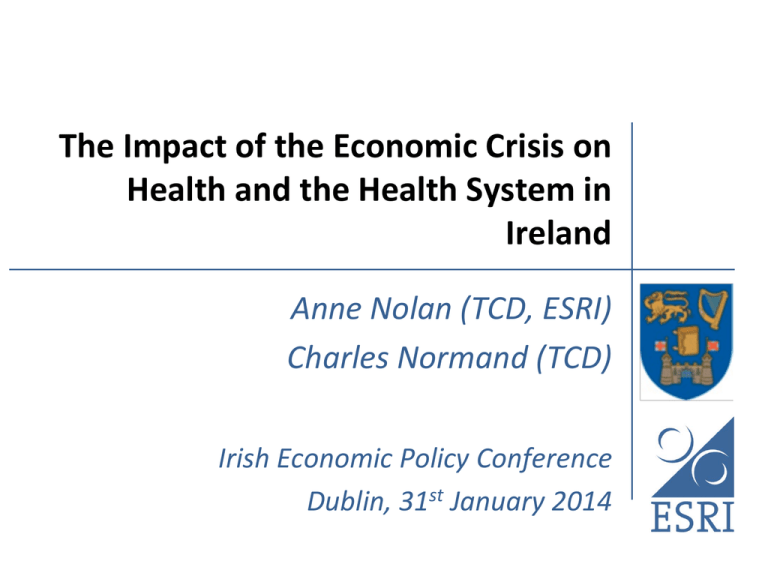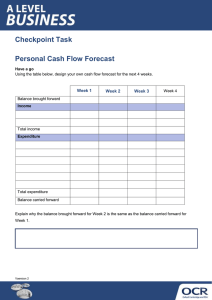The Impact of the Economic Crisis on Ireland Anne Nolan (TCD, ESRI)
advertisement

The Impact of the Economic Crisis on Health and the Health System in Ireland Anne Nolan (TCD, ESRI) Charles Normand (TCD) Irish Economic Policy Conference Dublin, 31st January 2014 Context Substantial health system pressures in Ireland Large, real declines in public expenditure 2 Total public health expenditure 2000-2013 18.0 €bn (capital + current) 16.0 14.0 12.0 10.0 8.0 6.0 4.0 2.0 0.0 2000 2001 2002 2003 2004 2005 2006 2007 2008 2009 2010 2011 2012 2013 nominal Sources: Department of Public Expenditure and Reform; CSO real (2000=1) Context Substantial health system pressures in Ireland Large, real declines in public expenditure External pressures: Demographic change (population growth; fertility) Internal pressures: Limited capacity in some sectors Weak primary and community care Demand-led schemes High costs (salaries; pharmaceuticals) Programme for Government commitments 4 Approach Review responses and policy levers in three key areas: Examine impact of crisis, and health system responses, on population health Level and mix of statutory resources for health Health cover Health service efficiency Mortality Self-assessed health Health behaviours Conclusions 5 1 Level and mix of statutory resources for health Statutory resources, i.e., payments that are pre-paid and mandatory General taxation (direct/indirect) Payroll taxes/social health insurance Mandatory health insurance (e.g., Netherlands) Principles: Adequate level Stability and predictability Fairness/equity Transparency Other (e.g., impact on labour costs) 6 Current situation in Ireland Public health expenditure as % of total health expenditure has been falling Trend in contrast to OECD average Increasing reliance on out-of-pocket payments and PHI Public health expenditure as % of total public expenditure has been relatively stable Initial pace of cuts could not be sustained 7 Public health expenditure as % total health expenditure, 2000-2011 % of total health expenditure 80.0 75.0 70.0 65.0 60.0 55.0 50.0 2000 2001 2002 2003 2004 2005 2006 2007 2008 2009 2010 2011 Ireland OECD Source: OECD 8 Public health expenditure as % of total public expenditure, 2008-2012 % of total public expenditure 30.0 28.0 26.0 24.7 24.6 24.4 2008 2009 2010 24.7 25.1 24.0 22.0 20.0 2011 2012 Source: Department of Public Expenditure and Reform 9 Policy options Continue with budget reductions ‘Earmark’ resources for health (within existing funds) Introduce a new source of statutory revenue, e.g., payroll tax But, off-setting reductions in general taxation Adequacy and stability (pro-cyclical fluctuations) Introduce a new source of statutory revenue, e.g., tax on sugar-sweetened drinks (SSD) Primary objective is behavioural change HIA report on SSD tax published in May 2013 10 2 Health cover Three aspects of public health cover: Breadth: who is covered? Scope: what is covered? Depth: how much is covered? Are there user fees? Principles, i.e., role of coverage in: Alleviating/exacerbating fiscal pressure Strengthening health system performance Enhancing efficiency in allocation and use of statutory resources 11 Current situation in Ireland Complex system of public healthcare entitlements Category I (full medical card) Category II Also GP visit card (since 2005) Other entitlements: LTI, HTD, etc. Role of private health insurance (PHI) Recent declines in cover 12 Population cover (%) 100% 90% 80% % of population 70% 60% 50% 40% 30% 20% 10% % Category I % GP Visit card 2012 2011 2010 2009 2008 2007 2006 2005 2004 2003 2002 2001 2000 1999 1998 1997 1996 1995 1994 1993 1992 1991 1990 0% % Category II Source: Thomson et al. (2012), Figure 4.2 13 Changes to statutory coverage Breadth Scope e.g., re-introduction of means test for over 70s in 2009, proposed extension of GP visit cards to all those 5 and under Reductions in dental, optical and aural entitlements Depth Increases in user fees (e.g., public hospital charges; prescription deductible for Category II) Introduction of new user fees (e.g., prescription fee-per-item for Category I) 14 Policy options Breadth Scope International trend is towards increasing coverage Removing coverage increases role for PHI (fiscal pressure via tax relief) Role of HTA Streamlining the benefit package is often technically and politically difficult to achieve Depth Usual arguments for user fees do not hold in health care May conflict with Programme for Government objectives 15 3 Health system efficiency Concerned with purchasing arrangements What to purchase? Who should purchase? From whom? At what price? Under what conditions? Principles: Matching resources to need Reducing waste Ensuring quality Setting priorities 16 Current situation in Ireland Purchasing largely co-ordinated by HSE Sometimes also plays a provider role Paying for primary care Paying for acute hospital care Reforming delivery structures Primary care teams Hospital trusts/groups Working practices 17 Policy options Payment of providers Reform of delivery structures GPs: increasing capitation component Acute hospitals: increased use of DRGs, MFTP Specialists: salary levels Primary care teams Integration across primary, community and acute sectors Hospital autonomy Input prices In particular, pharmaceuticals 18 Impact of economic crisis on health? Caveats Availability of timely data Time lags in effects Establishing causality (crisis, response to crisis, something else?) Large international literature on the impact of the macroeconomic cycle on population heath In general, mortality found to be procyclical (with exception of suicide) In general, poor physical health status found to be procyclical, while poor mental health status found to be countercyclical In general, negative health behaviours found to be procyclical Complex relationships (income, unemployment, leisure-time, stress, access to health care, etc.) All- and cause-specific mortality 2007-2010 (age standardised) 2007 (per 100,000 pop) 2010 (per 100,000 pop) change Cancer 246.8 227.3 Endocrine 22.8 19.5 Mental & behavioural 15.9 20.1 Nervous 28.9 29.4 Circulatory 322.6 272.0 Respiratory 110.1 95.6 Digestive 35.6 30.0 Genitourinary 22.3 19.6 External injury & poisoning 43.8 38.6 All causes 877.6 775.4 Note: Causes of death with rates below 10 are excluded Source: OECD 20 Mortality from ‘external causes of death’ 2007-2010 Deaths per 100,000 population (standardised) 14 12 10 8 6 4 2 0 2007 2008 Transport Accidents Source: OECD 2009 Intentional Self-Harm 2010 Self-assessed health & subjective well-being, 2007-2012 % >= ‘good’ self assessed health % ‘very’ satisfied with life 2007 84.2 33 2008 84.4 29 2009 83.4 29 2010 83.3 31 2011 83.4 29 2012 n/a 25 Sources: OECD; Eurobarometer Alcohol and tobacco consumption 2000-2011 16 3.0 14 2.5 2.0 10 8 1.5 6 1.0 4 0.5 2 0 0.0 2000 2001 2002 2003 2004 2005 2006 2007 2008 2009 2010 2011 Alcohol consumption (litres per capita) Source: OECD Tobacco consumption (kgs per capita) Kilos per capita Litres per capita 12 Summary Irish health system experiencing unprecedented cuts in expenditure Backdrop of external and internal pressures So far, cuts achieved by cutting staff numbers and pay; increased activity; increased user fees Ongoing concerns over ability to absorb further cuts (in context of rising demand and Programme for Government commitments) Difficult to ascertain impact on health at this stage 24 Further Challenges Questions over feasibility of future cuts in required timeframe Programme for Government commitments are welcome, but will require extra resources and strong governance Recognise the difficulty of improving efficiency in times of structural/organisational change Important to maintain a focus on policy goals 25 Contact Dr Anne Nolan Research Director, TILDA annolan@tcd.ie Professor Charles Normand Edward Kennedy Professor of Health Policy and Management, TCD normandc@tcd.ie

